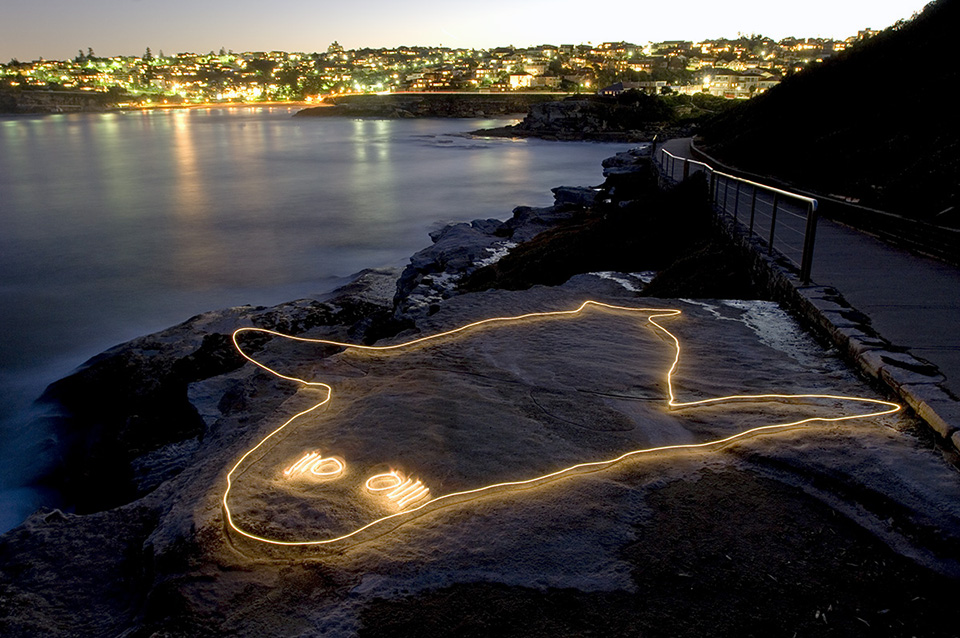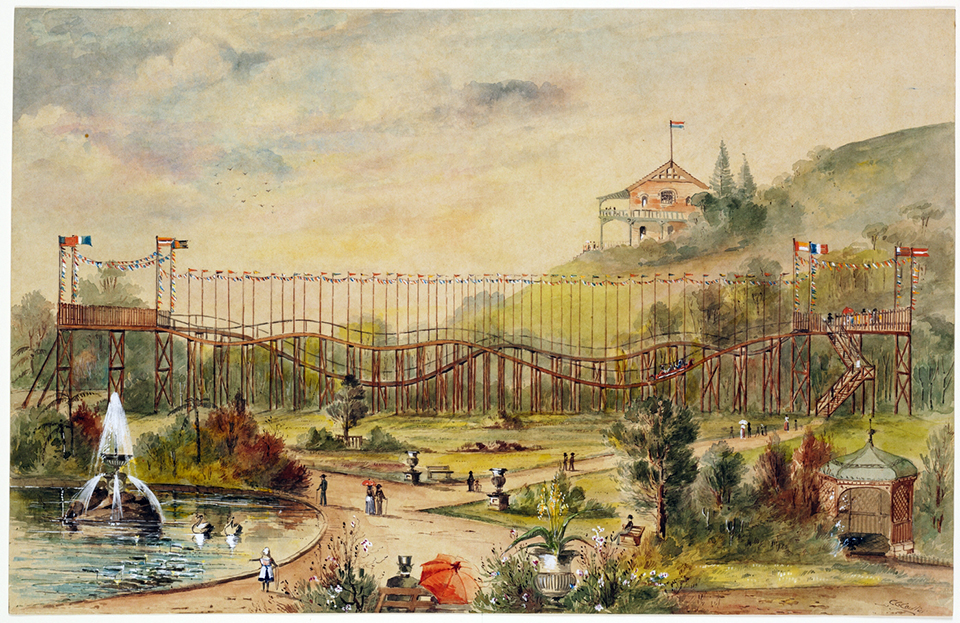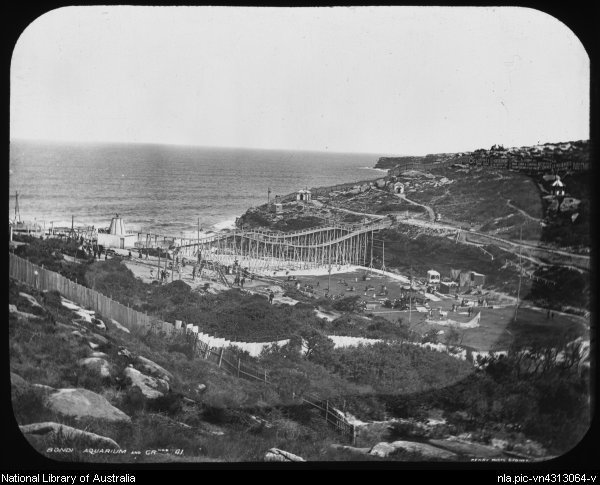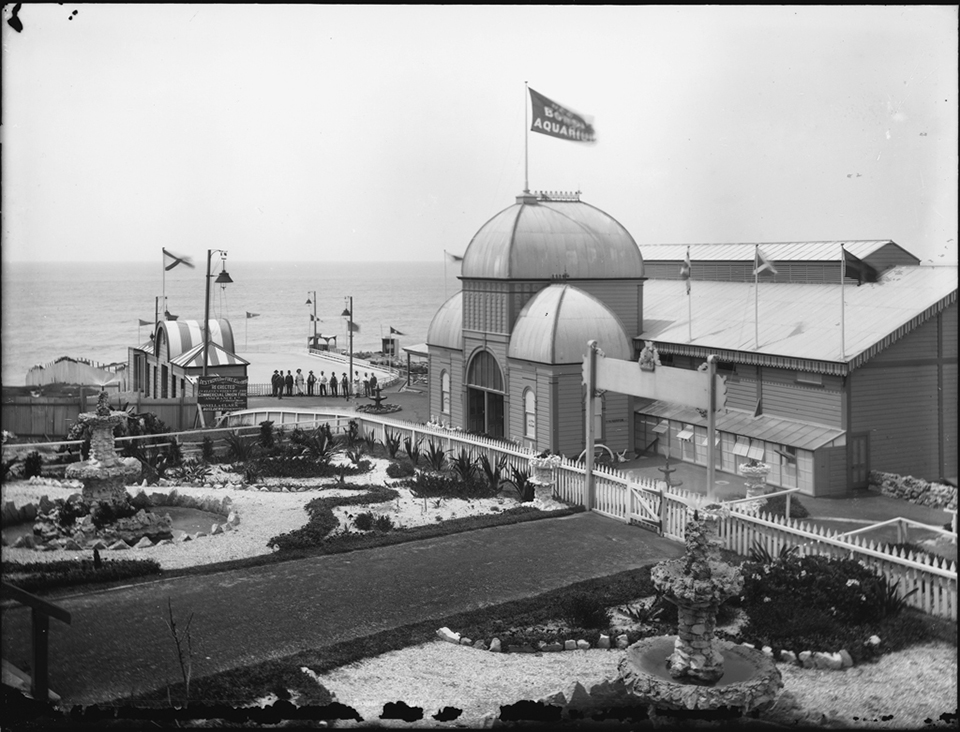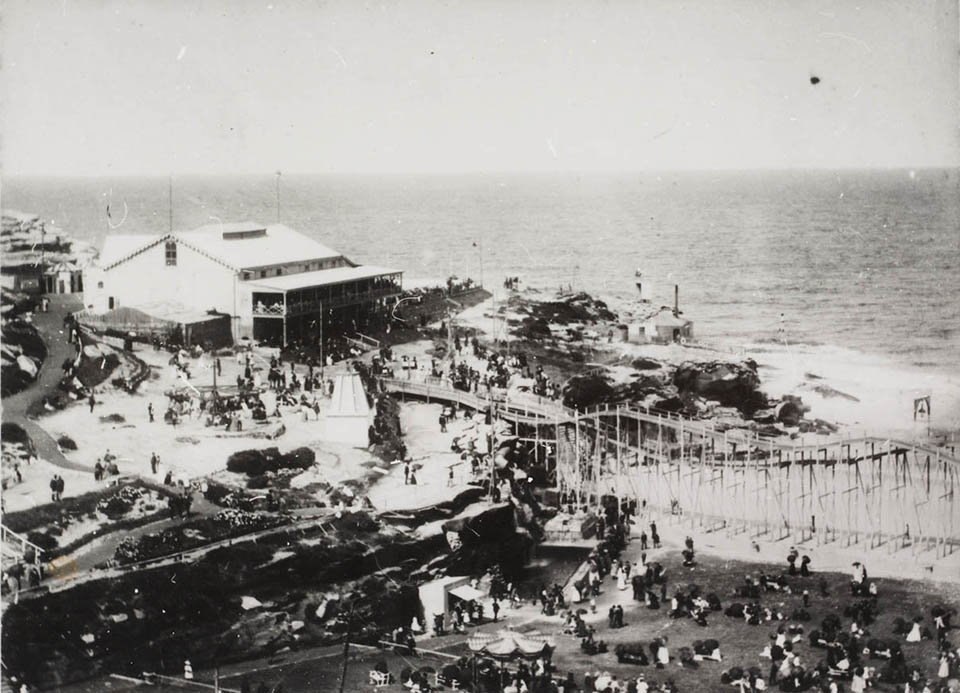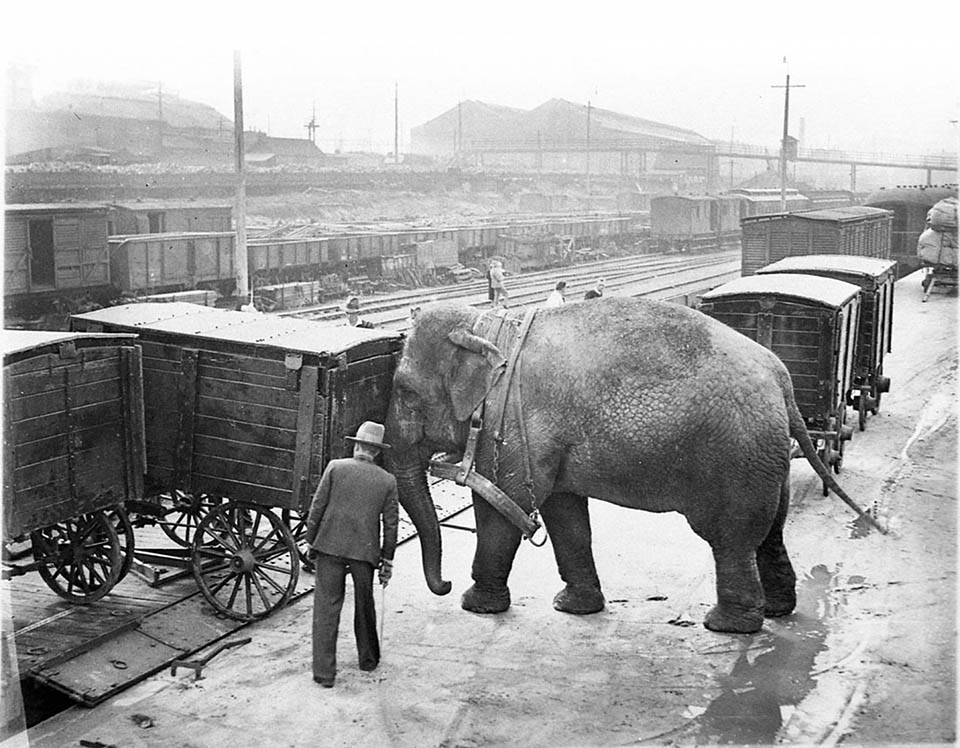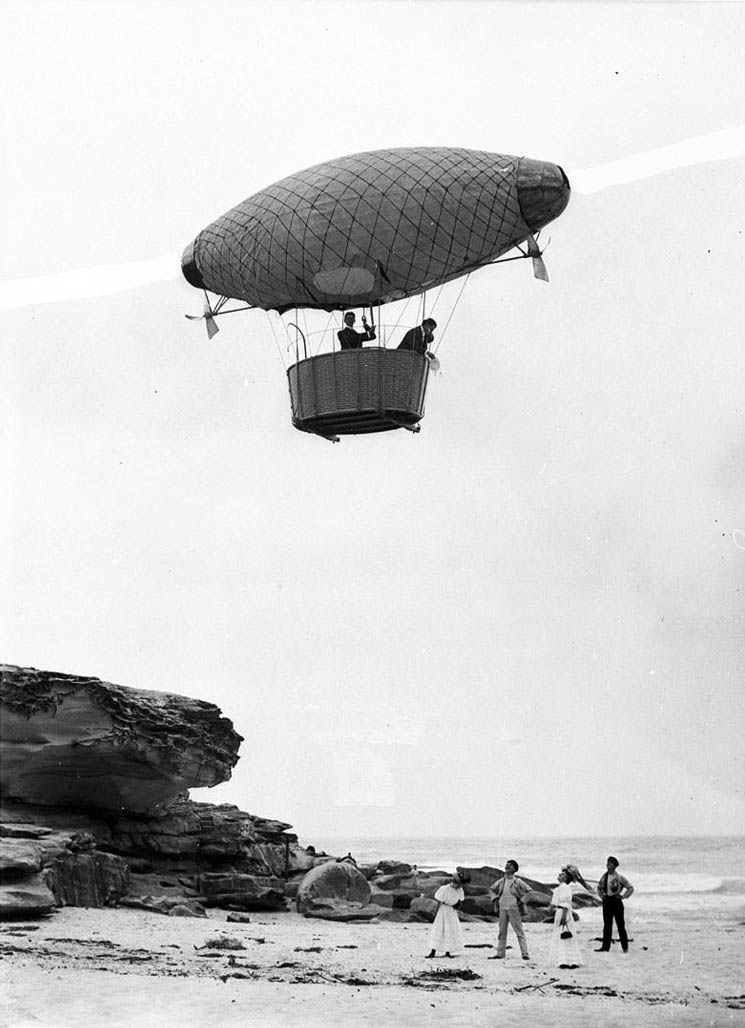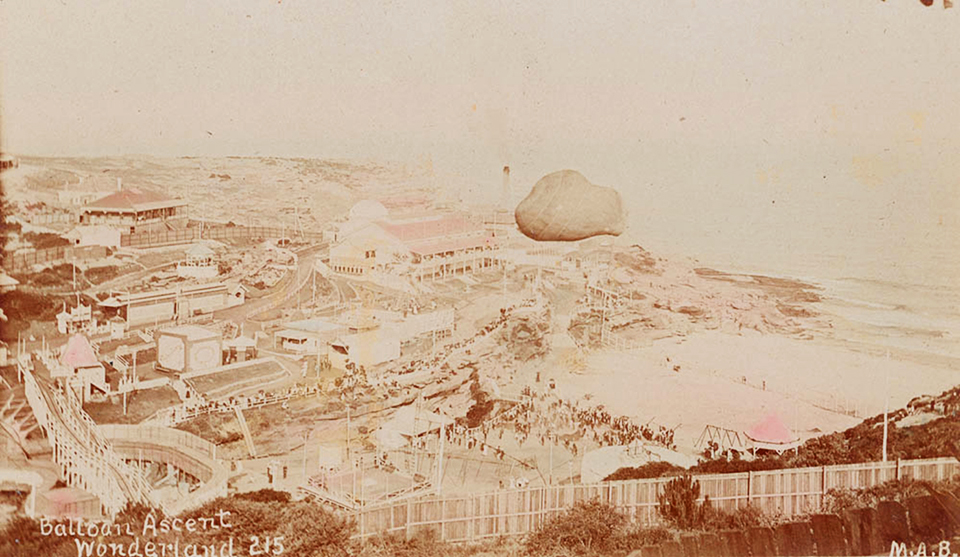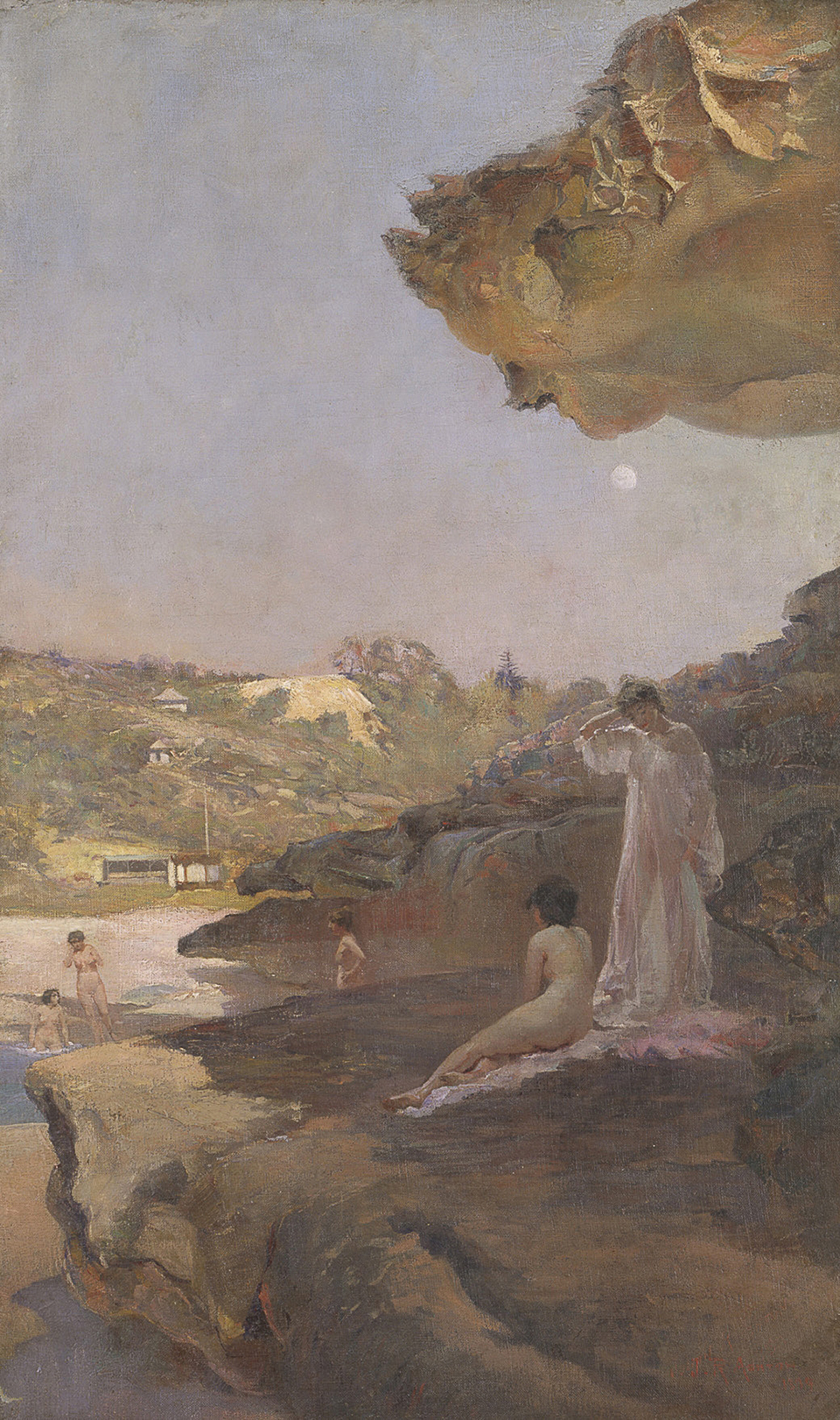The Dictionary of Sydney was archived in 2021.
Tamarama
Citation
Persistent URL for this entry
To cite this entry in text
To cite this entry in a Wikipedia footnote citation
To cite this entry as a Wikipedia External link
Tamarama
With rock shelters along the coastline making good living quarters and plentiful food and water available, it is unsurprising that there is clear evidence of Indigenous occupation of Tamarama long before European settlement.
Fresh water was available from the natural stream in Tamarama Gully behind the beach, and the ocean provided an abundant source of fresh seafood. Local midden deposits with an accumulation of shellfish refuse, and also evidence of fireplaces, attest to the level of food available.
One particular local midden atop a sandstone rock ledge has been classified by the National Parks and Wildlife Service as a site of archeological significance, because 'beachside shelters with midden deposits are rare on the Tasman Sea coast'. To protect it, the exact location of this midden is restricted information.
[media]Rock carvings on the coastal walk at Mackenzies Bay depict various fish species and were probably formed by the carver 'pecking' small holes in the rock surface with a pointed stone or shell, and later joining these together by grooving the rock. These abraded grooves carved into the rock face represent either a shark or a whale and two fish. The age of these engravings is not known, but they are estimated to be up to 2,000 years old.
From Gamma Gamma to Glamarama
The land on which Tamarama Park is now situated was granted to JR Hatfield in 1839 and was identified as 'Gamma Gamma', an Indigenous word. It is believed that this word means 'storm'.
Locals called the area Dixon's Bay after Dr Dixon, a nearby landowner. In the 1870s it became known as Fairlight Glen, named after a local house called Fairlight; then Fletcher's Glen, after David Fletcher, who owned a 10-acre (4-hectare) beach frontage and was the first Mayor of Waverley.
When conflicts between developers and residents hit the headlines in 2005, the Sydney Morning Herald dubbed Tamarama 'Dramarama'. Because the beach has attracted more than its fair share of A-list celebrities and 'beautiful people', the media has also jokingly referred to Tamarama as 'Glamarama'.
Royal Aquarium and Pleasure Grounds (the Bondi Aquarium)
From 1887 to 1891 the [media]Royal Aquarium and Pleasure Grounds occupied the northern headland of Tamarama where the Surf Life Saving Club now stands and Tamarama Park behind the beach. During this time Tamarama Beach was known as Aquarium Beach.
The Royal Aquarium and Pleasure Grounds was an open-air amusement park located behind Tamarama Beach and on the northern headland. Popularly known as the Bondi Aquarium (despite not being at Bondi), it opened on 1 October 1887, with a Grand Military Band, merry-go-rounds, swings, shooting gallery, water boats, camera obscura, Punch and Judy shows, and dancing. The Aquarium itself was one of the chief attractions, and included catfish, bream, whiting, mullet, lobsters, stingrays, porcupine-fish, turtles, a wobbegong shark and a tiger shark.
There was also a seal pond whose inhabitants shared their watery domain with a solitary penguin. [media]The most popular attraction was the Switchback Railway, an exciting, diving, plunging roller-coaster ride high above the beach. Two roller-skating rinks were 'illuminated by the electric light' and Pain's Grand Fireworks exploded every Wednesday, while the more demure 'Sacred and Classical Concerts' were held on Sundays.
Feats of skill and daring were a special feature and included a 'mounted sword contest', Alexander the acrobat who walked from cliff top to cliff top on a high wire, Captain George Drevar who floated on a 'cask raft' through the pounding surf, and a Grand Balloon Ascent and Parachute Descent. As well, in a large dance hall on the northern headland, headliners from Sydney's Tivoli Theatre entertained crowds; sometimes their appearance was described as being on the Aquarium Circuit.
[media]On the evening of 11 July 1891, fire destroyed the Aquarium and dance hall, but it rose from the ashes in September the same year, and continued to entertain Sydney's populace. The last identified concert at the Aquarium was a fund-raiser for the Waverley Benevolent Society in July 1906. Ownership and management changed several times throughout its existence, until the site was finally sold by the owner, Mrs Margaret J Lachaume, in 1906 to William Anderson, who transformed it into Wonderland City.
Wonderland City
William Anderson, a theatrical entrepreneur of rising prominence, leased the land formerly occupied by The Royal Aquarium and Pleasure Grounds in Tamarama Park, minus a 12-foot strip of coastline to allow the public access to the beach. He also leased further land in Tamarama Gully, then known as Tamarama Glen or simply 'the Glen', and constructed his 20-acre (8.08-hectare) outdoor entertainment masterpiece, Wonderland City.
[media]The main entrance was a large white weatherboard building in Wonderland Avenue near the point at which it joins Fletcher Street. The entry price was sixpence for adults and threepence for children, with all rides costing an additional fee.
Opening on Saturday, 1 December 1906, Wonderland claimed to equal 'those amusement grounds… of the far famed Coney Island, New York, or White City, Chicago'. Anderson also claimed 'there weren't sufficient trams in Sydney to transport the crowd … for the opening'.
On this opening night, approximately 20,00 people travelled out to Wonderland to go on fairground rides, view the novelty attractions and walk among the natural beauty of Tamarama Glen, which was lit by strings of electric lights and described as a 'fairy city'.
Some of the more unusual attractions included: an artificial lake, the first open-air ice skating rink in Australia, and the Airem Scarem, an airship that tracked on a cable from cliff to cliff and was supported on the cliffs at both ends by massive wooden structures. At high tide this airship ran over the sea. In addition to all of the older attractions, there was a Japanese tearoom, an Alpine slide and the Kings Theatre, a kind of music hall which could seat 1,000 people for variety shows.
Employing over 160 people, Wonderland set a new standard for Australian outdoor pleasure grounds. Large crowds, estimated at 2,000 people, came every summer weekend, with 70 turnstiles at the entrance doing a brisk trade.
Wonderland was known for its novelty and 'shocking' acts, with Anderson the consummate showman. [media]He organised for a couple to be married at Wonderland, and then paraded through the grounds on the back of Alice the elephant. One daredevil performer, Jack Lewis, roller-skated down a ramp, through a hoop of fire and landed in a tank with sharks – much to the horror of the crowd. Miraculously, Jack always survived unharmed.
Despite the 12-foot (3.6-metre) public access path to Tamarama Beach being excluded from his lease, Anderson installed an 8-foot-high (2.4-metre-high) wire fence across this land. He claimed this was necessary as fare-evaders were entering Wonderland by sneaking along the beach and under his beachfront boundary fence.
The barbed wire fence extended down the cliff on the southern end of the beach, across the rocks and sand to the rocks at the beach's northern end. However this wire fence also blocked access for swimmers to the beach. Some of these swimmers were influential businessmen and having their local beach cut off incensed them. The swimmers started an ongoing battle with Anderson; they would cut his wire fence, he would repair it and contact the police. The police would arrive and warn the swimmers and the following weekend the same scenario would be re-enacted.
George B Philip, the foundation President of the Tamarama Surf Life Saving Club, was one of these swimmers, and he later recalled how he got around one particular wire fence gatekeeper.
I scaled under the barbed wire fence practically every day. I knew every nook and corner of it – until I was caught by the gatekeeper. The outcome of this was that I came to an arrangement with him whereby that if I carried his billy of tea from the kiosk to (the) main gate at 5 o'clock each day, I could walk in and out when I liked (much to the envy of my mates, who were not caught)…
The stalemate between the swimmers and Anderson continued, with the swimmers eventually taking a deputation to New South Wales Parliament. On 6 March 1907, the Minister for Lands, James Ashton, issued an order to resume the 12-foot strip of land fronting the beach to 'give free access for all time to the beach at Tamarama Bay'.
Many of these victorious swimmers formed the nucleus of a new surf club, the Tamarama Surf Life Saving Club. On 11 February 1908 the first surf 'gymkhana' – equivalent to a surf carnival – was held at Wonderland on Tamarama Beach and was held each year until Wonderland closed.
Meanwhile, bad publicity dogged Wonderland. The conflict with local swimmers and the wire fence incident soured the public image of Wonderland, as did complaints that the animals were being poorly housed and mistreated. [media]The occasional breakdown of the Airem Scarem airship above the dangerous surf caused accusations of safety breaches, and resident opposition to the weekend revellers at Wonderland grew.
The [media]crowd numbers dropped but Anderson fought back, bringing in famous entertainers and more daring acts from his national touring circuit to perform at the King's Theatre. He also responded with more elaborate public exhibitions, but the public was tiring of Wonderland and the crowd numbers continued to drop. Wonderland struggled on from March 1908 to December 1910 with poorer crowds and low revenue, finally closing in 1911. Anderson is said to have lost £15,000 on Wonderland City.
Wonderland was the precursor of Luna Park, setting unprecedented standards for popular outdoor entertainment in Sydney. In its day it was the largest open-air amusement park in the southern hemisphere, and although little visible evidence of Wonderland survives today, with the possible exception of the two paths on the northern boundary of Tamarama Gully, the New South Wales Heritage Office still considers the site to be of archaeological significance.
When the amusement park Wonderland was in residence, the whole Tamarama beachside area – beach, park and gully – was called Wonderland City.
Julian Ashton's Tamarama
[media]In 1899 English-born artist Julian Rossi Ashton (1851–1942) painted Tamarama beach, forty years ago, a summer morning. This idyllic painting, of women lying nude and draped in gauze over the rocks on the Tamarama headland, was a highly romantic view of the area. Ashton is now remembered as an exponent of Australian impressionism who used to take his students on plein air painting excursions to the eastern suburbs beaches. Arriving in Australia in 1878, and in Sydney in 1883, Ashton painted Tamarama Gully, for The Picturesque Atlas of Australia.
He fell in love with Tamarama and settled locally. Another Australian artist, Elioth Gruner, also lived locally and there is evidence that an informal artist's colony may have existed at Tamarama at this time.
In 1889 Ashton painted a sketch of Tamarama Gully for Mary Anne Fletcher, daughter of David Fletcher. He wrote to her on 25 November that year:
Your father has no doubt handed you the little sketch of the Glen I did for you. If it gives you a [little] of the pleasure I have felt in that beautiful spot, I shall feel that the poor and unsuccessful effort I have made to reproduce those beauties is amply repaid.
Tamarama becomes Gallipoli
In 1915 Tamarama Beach earned its place in Australian film history when it was used as the location for 'Anzac Cove' in the World War I silent film drama, The Hero of the Dardanelles.
Made by Australasian Films, The Hero of the Dardanelles was the first feature film made about Gallipoli and was released less than three months after the actual landings. The director of the film was one of Australia's best silent filmmakers, Alfred Rolfe. In the film, essentially a World War I propaganda piece, a young Australian soldier is sent to Gallipoli, where he is dramatically wounded protecting Red Cross workers, but heroically survives. The filmmakers needed a long narrow cove, with cliffs either side, to reproduce the perceived look of Anzac Cove. Few Sydney beaches look like this – but Tamarama does. Two later films used the same film footage of Tamarama as Gallipoli, Spirit of Gallipoli (1928) and Within Our Gates (1915).
Plane crash at Tamarama
On 22 January 1946 surprised surfers and bathers at Tamarama and Bronte were buzzed by a Moth Minor aeroplane doing low stunts over the beach. It flew low and then crashed into Tamarama Bay. An eyewitness reported:
I saw him loop the loop twice. On the second occasion the engine appeared to cut out and the plane went into a tailspin at a height of about 300 feet. It then crashed into the sea.
The 29 year-old pilot, Eric Alfred Hurst, lost his life.
Tamarama Surf Life Saving Club reported,
The force of the impact caused the plane to break up, the wreckage being washed towards the beach, and many sightseers, disregarding the dangerous current running at the time, swam out to collect souvenirs.
So many persons were in danger of being swept out to sea that lifesavers had to use all the belts and reels available, plus surf skis for the rescue. At least four people were carried onto the beach unconscious, but all were revived.
Sydney's most dangerous beach?
Tamarama Beach [media]is only 100 metres long, and has been variously described as an embayed beach or a long inlet. But it is most notorious for its permanent rips, with the first recorded fatality at the beach in 1889.
In 1939 the Foundation President of Tamarama Surf Life Saving Club, George B Philip, claimed Tamarama was no more dangerous than Bronte or Bondi, but conceded that
nearly all the year round the undertow, both north and south side where the rocks are partly submerged, is strong.
Surf Life Saving NSW describes Tamarama as New South Wales's most hazardous patrolled beach, warning that its
energetic wave climate ensures that at least one and often two rips are present on the beach. This means the surf zone is essentially all rip.
It rates Tamarama at 8, on a scale of beach safety from 1 (the safest) to 10 (the most dangerous).
References
Jack Atkins, Wonderland City and Tamarama Beach, the author, Orient Point NSW, 2000
Warwick Mayne-Wilson, Tamarama Gully: A History, the author, Paddington NSW, 2008
Waverley Council, Tamarama Park Plan of Management, June 2007


